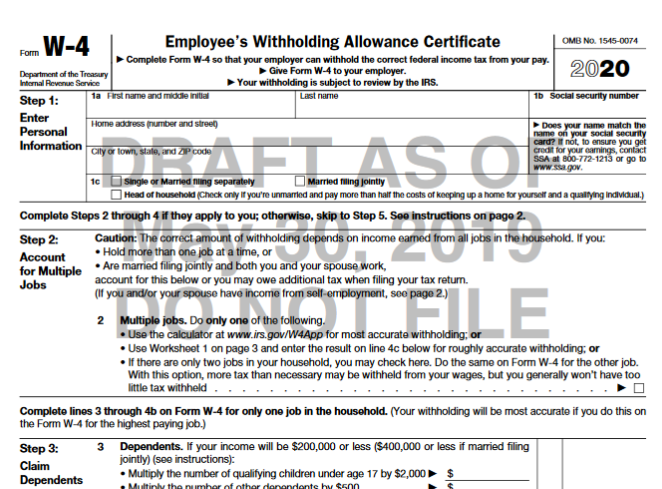It’s year-end again, which for employers means having to simultaneously figure out what year-end tax reporting requirements have changes, and what new compliance challenges the new year may bring. Many business leaders may find themselves in survival mode, with so much to know about new tax reporting guidelines, new health care reporting and other significant legislative considerations.
New IRS Form W-4 for 2020
The IRS has revamped Form W-4 and all related calculations for income tax withholding. The new form adds a new category, head of household, but more significantly, it eliminates withholding allowances altogether. Instead, employees will adjust their withholding by entering in their tax information on the W-4, such as other (non-wage) income, full-year deductions over the standard deduction amount and any child or dependent tax credits.
Filling out the new Form W-4 could be more labor-intensive, as new hires likely won’t have their previous tax return memorized. You may need to adjust your onboarding process around how people fill out their W-4. You could, for instance, offer them some time and a private room to call for tax help, or give them a day to complete the form at home.
Starting in 2020, new hires will have to use this updated W-4 Form. If your current employees are happy with their current tax withholding, they can continue the same approach. But if they want to change their withholding after the end of this year, they will need to use the new system.
State Withholding
The new Form W-4 could also affect state tax withholding, as state governments typically base their approach on the IRS system, and state governments are still figuring out how to accommodate the new W-4. Some states continue to use allowances on their withholding tables and rely exclusively on the IRS Forms W-4 for state tax purposes, yet there is no longer an entry box for allowances on the federal form. Expect some year-end changes from state governments as they plan their response to the new IRS Form W-4.
Some state governments are also reacting to the new $10,000 limit on federal deductions for state/local taxes under the Tax Cuts and Jobs Act. One possible solution could be reducing income taxes and increasing payroll taxes, which remain deductible. New York launched an optional payroll tax, and Connecticut is running a study to determine whether it should enact a broad mandate de-emphasizing income taxes and shifting to a payroll tax. This could become more common as states figure out how to operate under the Tax Cuts and Jobs Act.
Federal W-2s and State Deadlines
In 2020, the estimated Social Security maximum taxable earnings will be $137,700, while the tax rate will remain the same for employers and employees at 6.2%. Medicare tax rates will remain the same as they were in 2019: 1.45% for employers, 1.45% for employees with earnings up to $200,000 and 2.35% for wages over $200,000.
The IRS continues to prioritize preventing tax refund fraud and identity theft and has moved the W-2 submission deadline earlier to Jan. 31 in order to do so. As a result, they’ve discontinued their W-2 verification code pilot program from the past few years.
At the state level, many governments are also moving their W-2 reporting deadlines forward, typically to Jan. 31. In addition, most states now require electronic W-2 filing from employers. Several states have also increased their penalties for late filing of W-2s, so this is something to be careful of in the coming months.
ACA Compliance from States
The Tax Cuts and Jobs Act removed the individual mandate and federal tax penalty from the ACA. Supporters of the ACA believed this was a crucial part of making the healthcare law work. In response, several states are looking to create an individual mandate and tax penalty for their residents.
California, Massachusetts, New Jersey, Rhode Island, Vermont and Washington, D.C. have already passed laws, while other states are considering similar legislation. This could create extra headaches for employers — instead of dealing with one version of ACA compliance at the federal level, they would be required to navigate the rules and filing requirements in each state where they do business. Critically, most of the states that have enacted an individual mandate will also require employers to report to the state details of employee health coverage.
Gig Economy and Worker Classification
In a recent court case, California reshaped its rules around the gig economy and worker classification. The ruling tightened the standards for when a business can classify workers as independent contractors. For someone to count as a contractor in California going forward, all the following conditions must be met:
· “The person is free from control and direction of the hiring entity.”
· “The person performs work that is outside the usual course of the hiring entity’s business.”
· “The person is customarily engaged in an independently established trade, occupation or business of the same nature as the work performed.”
This new rule kicks off in 2020 and could lead to thousands of contractors becoming reclassified as employees in California. While this change only applies to one state so far, it may set the stage for other states to follow suit.
To learn more about these and other potential tax and compliance issues, like the current state of FUTA, listen to our webinar, Strategies for Surviving Year End Reporting, which is available on-demand. It’s your chance to hear from experts on all the year-end report topics as you prepare for 2020.
=======
This story originally published on SPARK (www.ADP.com/SPARK), a blog designed for you and your people by ADP. Pete Isberg is Vice President of Government Relations for ADP.
Thanks for reading CPA Practice Advisor!
Subscribe Already registered? Log In
Need more information? Read the FAQs
Tags: Payroll





